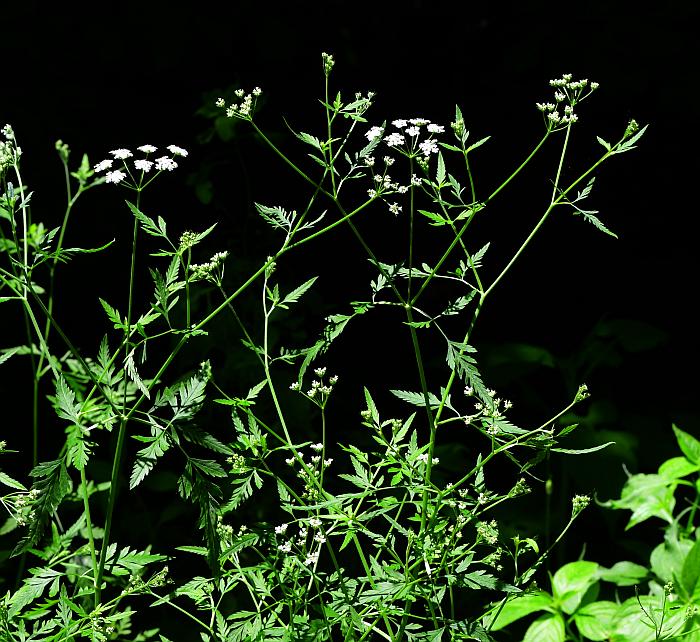Torilis arvensis (Huds.) Link
Field Hedge-Parsley

Introduced
CC = *
CW = 5
MOC = 77
© SRTurner
Torilis arvensis (Huds.) LinkField Hedge-Parsley | |
 |
Introduced CC = * CW = 5 MOC = 77 |
© SRTurner |
|
Family - Apiaceae Habit - Annual forb. Stem - Ascending to erect, to 1.0 m, usually relatively slender, pubescent with stiff, white, retrorse hairs.
Leaves - alternate and basal, compound. Basal and lower stem leaves short-to long-petiolate, grading to sessile or nearly so upward, the sheathing bases not or only slightly inflated, with glabrous margins. Blades to 15 cm long, narrowly oblong-ovate to ovate-triangular in outline, 1 or 2 times pinnately compound, the leaflets 5-60 mm long, lanceolate to oblong-ovate, usually deeply pinnately dissected, mostly narrowed at the base, the lobes with the margins mostly sharply few-toothed, narrowed to a sharp point at the tip, moderately to densely pubescent with stiff, appressed white hairs on both surfaces.
Inflorescences - Terminal, and sometimes also axillary, compound umbels, these short-to long-stalked. Involucre absent or of 1-2 bracts, these 1-12 mm long, narrowly triangular to more commonly linear, often hairlike. Rays 3-10, 0.5-2.5 cm long. Flower stalks 1-4 mm long, the umbellets thus often appearing dense and headlike. Flowers 5-20 per umbellet.
Flowers - Sepals absent or minute triangular scales. Petals obovate to fan-shaped, rounded or shallowly notched at the tip, white. Ovaries hairy.
Fruits - Schizocarps 3-5 mm long. Bristles all elongate, 0.6-1.1 mm long, about as long as the width of the body of the mericarp, spreading at nearly 90 degrees from the fruit, straight or slightly arched, terminating in a minute barb.
Flowering - June - September. Habitat - Streambanks, glades, prairies, savannas, roadsides, railroads, fields, pastures, open, disturbed areas. Origin - Native to Eurasia. Lookalikes - Other species of Torilis (relatively rare in Missouri). More broadly, many other members of the Apiaceae. Other info. - This introduced weed was first collected in Missouri in 1908, and in the intervening century has spread rampantly, now probably present in every county in the state. It is particularly prevalent in the lower U.S. Midwest, but also occurs across much of the Southwest and the West Coast. It is identified by its compound umbels of white florets, bristly fruits, divided leaves, and by the characteristic appressed white hairs on the stems and leaves. Specimens with mature fruits are rigorously avoided by those in the know, since the abundant fruits stick tenaciously to clothing and are difficult to remove. This adhesion is so strong that removal of the fruits from hairy legs can be a painful experience. At best, a walk through the plants will incur the price of significant time spent tediously pulling the fruits from fabric, unless the affected articles of clothing are to be discarded. Photographs taken at Busch Wildlife Area, St. Charles County, MO, 7-2-2006, Weldon Spring Conservation Area, St. Charles County, MO, 6-20-2009, city of Washington, Franklin County, MO, 6-6-2019, and along the Katy Trail near Marthasville, Warren County, MO, 5-24-2020 (SRTurner). |